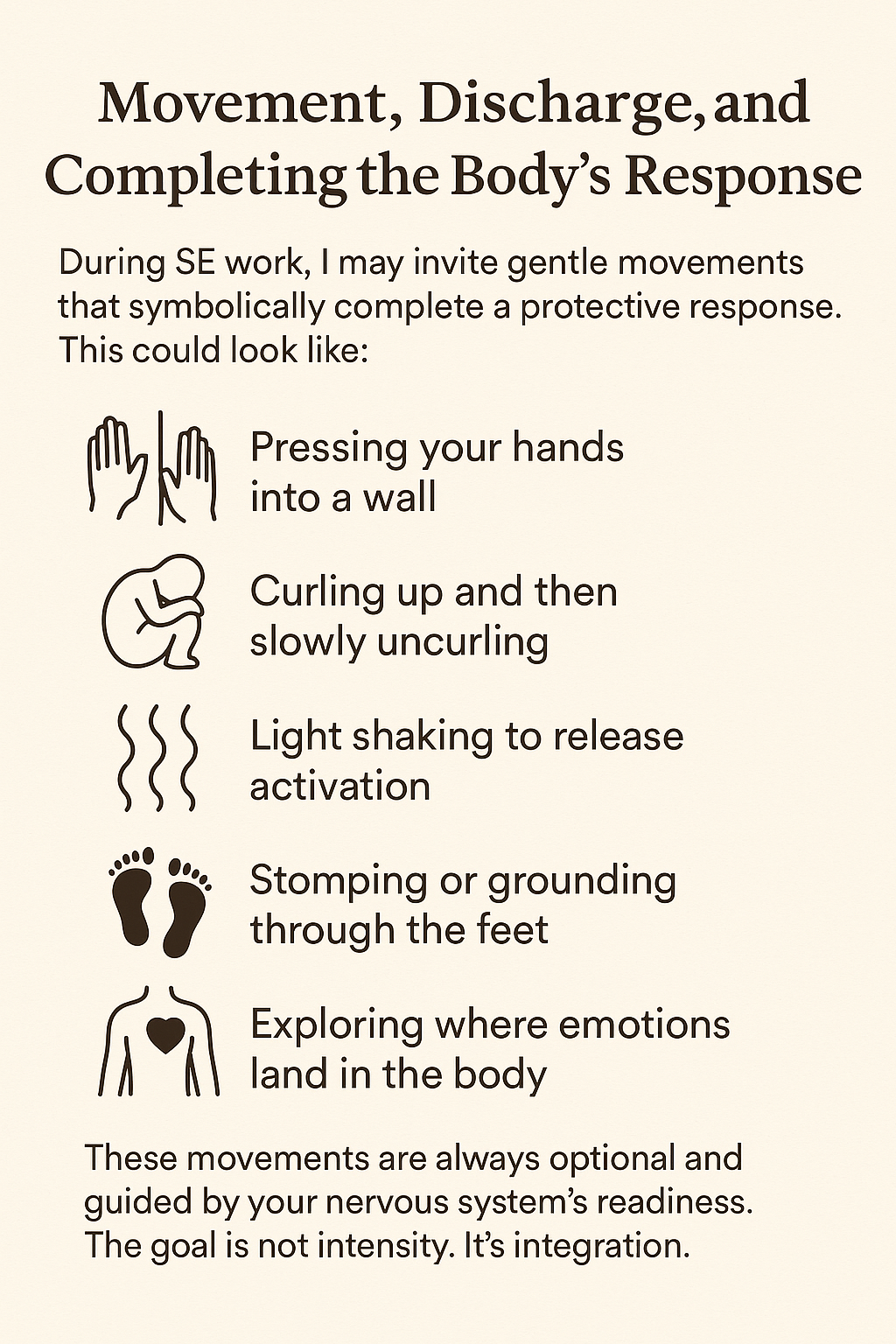Somatic Experiencing: A Gentle, Body-First Path to Healing Trauma
When I sit with clients, I’m always reminded that trauma doesn’t live in our thoughts alone. It lives in the body—through breath, tension, bracing, collapsing, or moving through life on high alert even when the danger has long passed. Our bodies hold the stories we weren’t able to speak, and they often try to protect us long after the threat is gone.
Somatic Experiencing® (SE), developed by Dr. Peter Levine, offers a compassionate, body-based way to support those protective systems. Rather than focusing on retelling painful memories, SE helps the nervous system complete responses that were interrupted during overwhelming experiences. I appreciate this approach because it honors the body’s natural pace and wisdom, allowing healing to unfold gently and safely.
What Somatic Experiencing Is (and Why It Matters)
Somatic Experiencing is a bottom-up trauma therapy that works directly with physiological patterns—tightness, numbness, shaking, collapse, or hypervigilance—that often appear before we can put anything into words. I often tell clients that even when memories are blurry or incomplete, the body remembers.
I frequently meet people who say things like:
-
“I know I’m safe now, but my body doesn’t feel safe.”
-
“I freeze or shut down even when I don’t want to.”
-
“My anxiety shows up as jaw clenching or a tight chest.”
These reactions are not personal failings. They are survival responses that once helped protect you. SE gives us space to meet these patterns with curiosity and compassion, rather than shame.
One of the most meaningful parts of SE for me is how it bridges the gap between intellectually knowing you’re safe and truly feeling safe in your body.
How Somatic Experiencing Works in Therapy
SE is not dramatic or forceful. It’s gentle, relational, and attuned to your nervous system. In our work together, we might explore:
-
Noticing sensations like warmth, tightness, or tingling
-
Tracking how those sensations shift over time
-
Experimenting with small, supportive movements or postures
-
Moving between what feels resourced and what feels more activated
This movement between activation and ease—called pendulation—helps the nervous system learn that it can approach difficult sensations without becoming overwhelmed.
Sometimes this includes light movement. For example, if someone froze during a past event, we might explore what it feels like to push their hands into a chair or stand and shift their weight. These small actions allow the body to complete what it couldn’t finish during the original experience. It’s not about reliving trauma; it’s about closing a loop the body never got to close.

Do You Need to Retell the Whole Story?
You don’t.
Some people come in with a clear memory they want to work on. Others don’t remember much at all. SE doesn’t require a detailed narrative. We can work entirely with what’s happening in the body today, in the present moment.
This can be especially reassuring for clients who know something happened but don’t have full access to the details due to age, shock, dissociation, or the brain’s protective mechanisms.
Movement, Discharge, and Completing the Body’s Response
During SE work, I may invite gentle movements that symbolically complete a protective response. This could look like:
-
Pressing your hands into a wall
-
Curling up and then slowly uncurling
-
Light shaking to release activation
-
Stomping or grounding through the feet
-
Exploring where emotions land in the body
These movements are always optional and guided by your nervous system’s readiness. The goal is not intensity. It’s integration.

What Somatic Experiencing Can Support
While SE was originally developed for trauma, it can help with a wide range of experiences, including:
-
PTSD and complex trauma
-
Chronic stress and anxiety
-
Medical trauma and surgical recovery
-
Car accidents or sudden shocks
-
Birth trauma
-
Assault or inescapable situations
-
Body symptoms linked with past trauma
In psychiatric work, I often see clients who continue to experience physical symptoms even after medical clearance. SE can help us explore how unprocessed stress or overwhelm might be showing up in the body—not as “it’s all in your head,” but as a reminder that the brain, body, and nervous system are deeply connected.
Why Somatic Experiencing Fits the Catalyst Center’s Integrative Approach
At The Catalyst Center, we deeply value nervous system regulation as a foundation for trauma recovery. SE integrates beautifully with other approaches we offer, including EMDR, Brainspotting, integrative psychiatry, and yoga-based therapies.
It aligns with what many of us already see in our work: our bodies often carry what our minds can’t yet name. SE provides a structured, compassionate way to explore those experiences safely.
A Gentle Way Back Into Your Body
Trauma stored in the body doesn’t dissolve through force—it softens when we approach it with patience, presence, and relationship. That’s the heart of Somatic Experiencing.
For many people, trauma creates a sense of disconnection from the body—or even a feeling that the body has betrayed them. SE helps rebuild trust in slow, manageable steps. I want my clients to know that they never have to face overwhelming sensations all at once. We go piece by piece, honoring your pace.
Over time, people often describe feeling more grounded, more connected, and less at war with themselves. It’s a return to wholeness—not through force, but through gentle reconnection.
Discover a Compassionate, Body-Based Path to Healing
If you’re curious about exploring trauma healing in a body-based, compassionate way, I’d be honored to support you. The Catalyst Center has a team of trauma specialists here to walk with you as you reconnect with safety and regulation.
Ready to get started?
Our team specializes in helping individuals gently reconnect with their bodies after trauma.
If you’re ready to explore how Somatic Experiencing and nervous system–based therapy can help you release what your body has been holding, we’re here to help.




